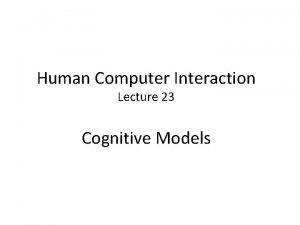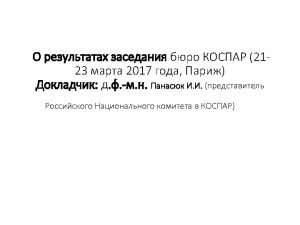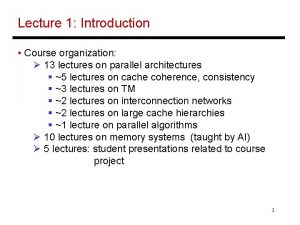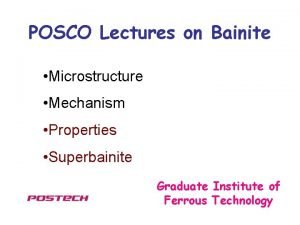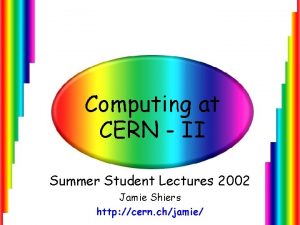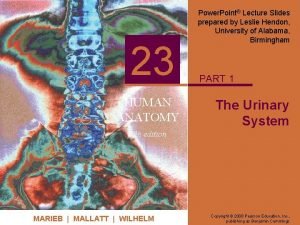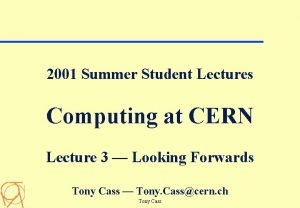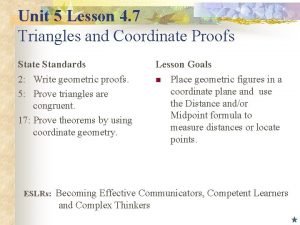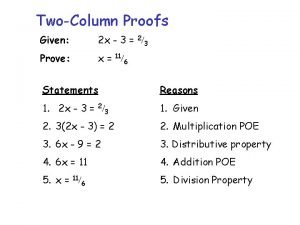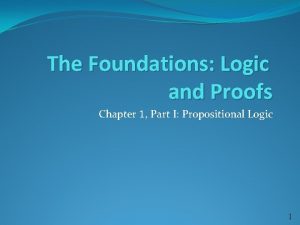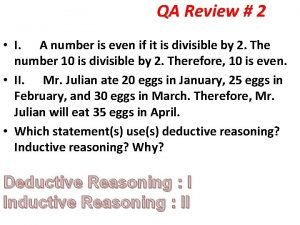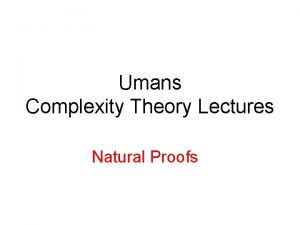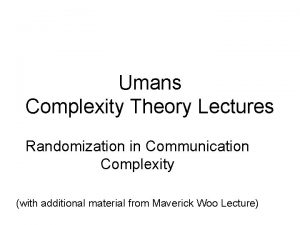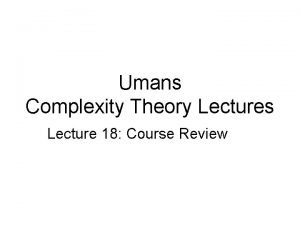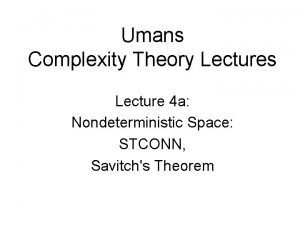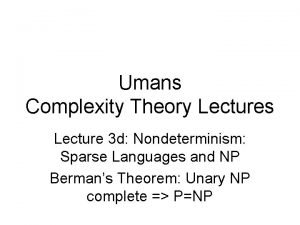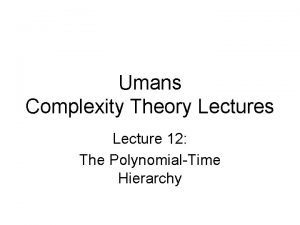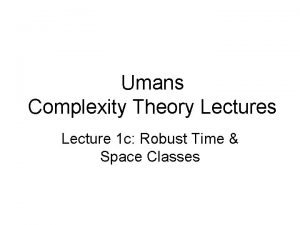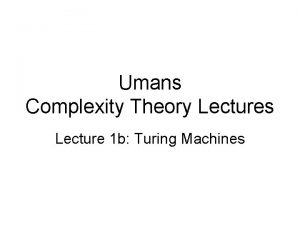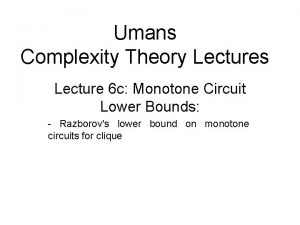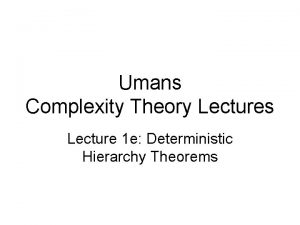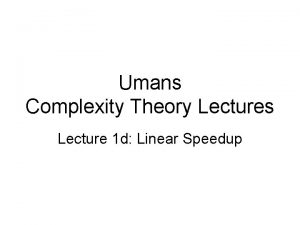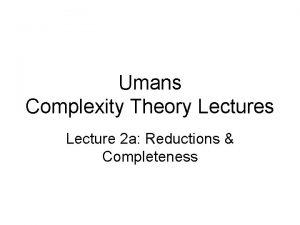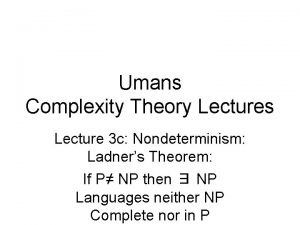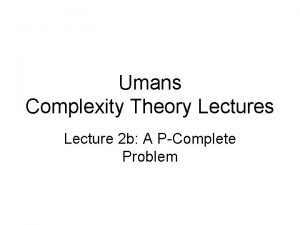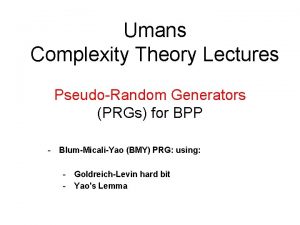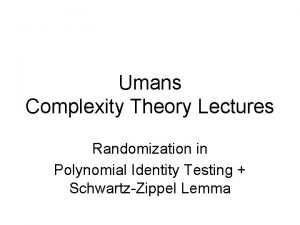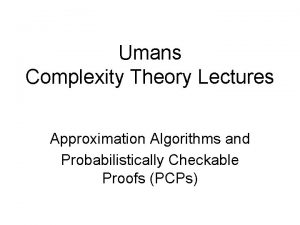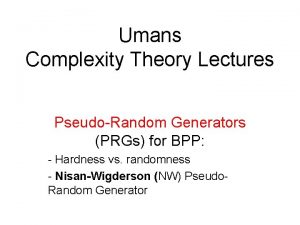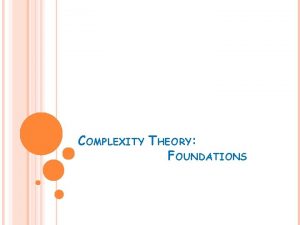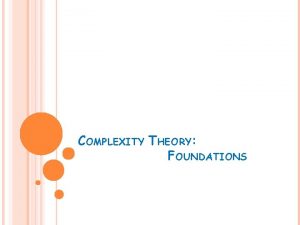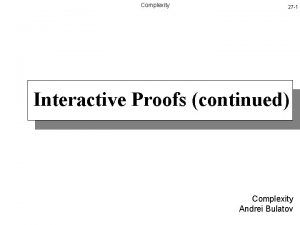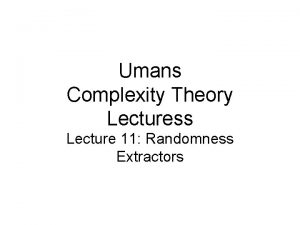Umans Complexity Theory Lectures Lecture 14 Interactive Proofs












































![Arthur-Merlin Games • Delimiting # of rounds: – AM[k] = Arthur-Merlin game with k Arthur-Merlin Games • Delimiting # of rounds: – AM[k] = Arthur-Merlin game with k](https://slidetodoc.com/presentation_image_h/1ff089d8e6bc98dedf4d34b27973c930/image-45.jpg)
![Arthur-Merlin Games Theorem: for all constant k 2 AM[k] = AM[2]. • Proof: – Arthur-Merlin Games Theorem: for all constant k 2 AM[k] = AM[2]. • Proof: –](https://slidetodoc.com/presentation_image_h/1ff089d8e6bc98dedf4d34b27973c930/image-46.jpg)
![Arthur-Merlin Games • Proof (continued): – given L MA[2] x L ∃m Prr[(x, m, Arthur-Merlin Games • Proof (continued): – given L MA[2] x L ∃m Prr[(x, m,](https://slidetodoc.com/presentation_image_h/1ff089d8e6bc98dedf4d34b27973c930/image-47.jpg)
![MA and AM • Two important classes: – MA = MA[2] – AM = MA and AM • Two important classes: – MA = MA[2] – AM =](https://slidetodoc.com/presentation_image_h/1ff089d8e6bc98dedf4d34b27973c930/image-48.jpg)







![Using PRGs for MA poly(n) • can compute Prz[Cx, m(G(z)) = 1] exactly – Using PRGs for MA poly(n) • can compute Prz[Cx, m(G(z)) = 1] exactly –](https://slidetodoc.com/presentation_image_h/1ff089d8e6bc98dedf4d34b27973c930/image-56.jpg)










![Using PRGs for AM x L [Prz[Cx(G(z)) = 1] ½ + ²] • Cx Using PRGs for AM x L [Prz[Cx(G(z)) = 1] ½ + ²] • Cx](https://slidetodoc.com/presentation_image_h/1ff089d8e6bc98dedf4d34b27973c930/image-67.jpg)



- Slides: 70

Umans Complexity Theory Lectures Lecture 14: Interactive Proofs

New Topic • proof systems • interactive proofs and their power • Arthur-Merlin games 2

Proof systems L = { (A, 1 k) : A is a true mathematical assertion with a proof of length k} What is a “proof”? complexity insight: meaningless unless can be efficiently verified 3

Proof systems • given language L, goal is to prove x L • proof system for L is a verification algorithm V – completeness: x L ∃ proof, V accepts (x, proof) “true assertions have proofs” – soundness: x L ∀ proof*, V rejects (x, proof*) “false assertions have no proofs” – efficiency: ∀ x, proof: V(x, proof) runs in polynomial time in |x| 4

Classical Proofs • previous definition: “classical” proof system • recall: L NP iff expressible as L = { x | ∃y, |y| < |x|k, (x, y) R } and R P. • NP is the set of languages with classical proof systems (R is the verifier) 5

Interactive Proofs • Two new ingredients: randomness: verifier tosses coins, errs with some small probability interaction: rather than “reading” proof, verifier interacts with computationally unbounded prover • NP proof systems lie in this framework: prover sends proof, verifier does not use randomness 6

Interactive Proofs • interactive proof system for L is an interactive protocol (P, V) common input: x Prover Verifier. . # rounds =. poly(|x|) accept/ reject 7

Interactive Proofs • interactive proof system for L is an interactive protocol (P, V) completeness: x L Pr[V accepts in (P, V)(x)] 2/3 soundness: x L ∀ P* Pr[V accepts in (P*, V)(x)] 1/3 efficiency: V is p. p. t. machine • repetition: can reduce error to any ε 8

Interactive Proofs IP = {L : L has an interactive proof system} • Observations/questions: – philosophically interesting: captures more broadly what it means to be convinced a statement is true – clearly NP IP. Potentially larger. How much larger? – if larger, randomness is essential (why? ) 9

Graph Isomorphism • graphs G 0 = (V, E 0) and G 1 = (V, E 1) are isomorphic (G 0 G 1) if exists a permutation π: V V for which (x, y) E 0 (π(x), π(y)) E 1 1 4 2 3 4 3 24 10

Graph Isomorphism • GI = {(G 0, G 1) : G 0 G 1 } in NP not known to be in P, or NP-complete • GNI = complement of GI not known to be in NP Theorem (GMW): GNI IP indication IP may be more powerful than NP 11

GNI in IP • interactive proof system for GNI: input: (G 0, G 1) Prover if H G 0 r = 0, else r = 1 H = π(Gc) r Verifier flip coin c {0, 1}; pick random π accept iff r = c 12

GNI in IP • completeness: If G 0 not isomorphic to G 1 then H is isomorphic to exactly one of (G 0, G 1) Prover will choose correct r • soundness: If G 0 G 1 then prover sees same distribution on H for c = 0, c = 1 If no information on c any prover P* can succeed with probability at most 1/2 13

The power of IP • We showed GNI IP • GNI IP suggests IP more powerful than NP, since we don’t know how to show GNI in NP • GNI in co. NP Theorem (LFKN): co. NP IP 14

The power of IP • Proof idea: input: φ(x 1, x 2, …, xn) – prover: “I claim φ has k satisfying assignments” – true iff • φ(0, x 2, …, xn) has k 0 satisfying assignments • φ(1, x 2, …, xn) has k 1 satisfying assignments • k = k 0 + k 1 – prover sends k 0, k 1 – verifier sends random c {0, 1} – prover recursively proves “φ’ = φ(c, x 2, …, xn) has kc satisfying assignments” – at end, verifier can check for itself. 15

The power of IP • Analysis of proof idea: Completeness: φ(x 1, x 2, …, xn) has k satisfying assignments accept with prob. 1 Soundness: φ(x 1, x 2, …, xn) does not have k satisfying assigns. accept prob. 1 – 2 -n So Not a Sound Proof System – Why? It is possible that k is only off by one; verifier only catches prover if coin flips c are successive bits of this assignment 16

The power of IP • Solution to problem (ideas): – replace {0, 1}n with (Fq)n – verifier substitutes random field element at each step – vast majority of field elements catch cheating prover (rather than just 1) Theorem: L = { (φ, k): CNF φ has exactly k satisfying assignments} is in IP 17

The power of IP • First step: arithmetization Transform φ(x 1, … xn) into polynomial pφ(x 1, x 2, … xn) of degree d over a field Fq; q prime > 2 n Recursively: • xi φ (1 - pφ) • φ φ’ (pφ)(pφ’) • φ φ’ 1 - (1 - pφ)(1 - pφ’) For all x {0, 1}n we have pφ(x) = φ(x) Degree(pφ(x)) = d |φ| Can compute pφ(x) in poly time from φ and x 18

The power of IP • Prover wishes to prove: k = Σx 1 = 0, 1Σx 2 = 0, 1 … Σxn = 0, 1 pφ(x 1, x 2, …, xn) • Define: kz = Σx 2 = 0, 1 … Σxn = 0, 1 pφ(z, x 2, …, xn) • prover: sends kz for all z Fq (will improve this later) verifier: – checks that k 0 + k 1 = k – sends random z Fq • continue with proof that kz = Σx 2 = 0, 1 … Σxn = 0, 1 pφ(z, x 2, …, xn) • at end: verifier checks for itself 19

The power of IP • Prover wishes to prove: k = Σx 1 = 0, 1Σx 2 = 0, 1 … Σxn = 0, 1 pφ(x 1, x 2, …, xn) • Define: kz = Σx 2 = 0, 1 … Σxn = 0, 1 pφ(z, x 2, …, xn) • a problem: can’t send kz for all z Fq • solution: send the polynomial ! – recall degree d |φ| 20

The actual protocol Prover input: (φ, k) p 1(x) = Σx 2, …, xn {0, 1} pφ(x, x 2, …, xn) z 1 p 2(x) = Σx 3, …, xn {0, 1} pφ(z 1, x, x 3, …, xn) p 2(x) z 2 Verifier p 1(0)+p 1(1)=k? pick random z 1 in Fq p 2(0)+p 2(1)=p 1(z 1)? pick random z 2 in Fq p 3(x) = Σx 4, …, xn {0, 1} pφ(z 1, z 2, x, x 4 …, xn) p 3(0)+p 3(1)=p 2(z 2)? p 3(x). . pick random z 3 in Fq pn(x) pn(0)+pn(1)=pn-1(zn-1)? pn(zn) = pφ(z 1, z 2, …, zn)? pick random zn in Fq 21

Analysis of protocol • Completeness: – if (φ, k) L then honest prover on previous slide will always cause verifier to accept 22

Analysis of protocol • Soundness: – let pi(x) be the correct polynomials – let pi*(x) be the polynomials sent by (cheating) prover – Note: each pi(x) and pi*(x) of degree at most d |φ|(so have at most d zeros) over a field Fq; q prime > 2 n (φ, k) L p 1(0) + p 1(1) ≠ k either p 1*(0) + p 1*(1) ≠ k (and V rejects) or p 1* ≠ p 1 Prz 1[p 1*(z 1) = p 1(z 1)] degree(p 1*-p 1)/q d/q |φ|/2 n Assume pi+1(0)+pi+1(1) = pi(zi) ≠ pi*(zi) either pi+1*(0) + pi+1*(1) ≠ pi*(zi) (and V rejects) 23 or pi+1* ≠ pi+1 Przi+1[pi+1*(zi+1) = pi+1(zi+1)]

Analysis of protocol • Soundness (continued): If verifier does not reject, there must be some i for which: pi* ≠ pi and yet pi*(zi) = pi(zi) For each i, probability is degree(pi*-pi)/q |φ|/2 n Union bound: probability that there exists an i for which the bad event (out of n events) occurs is n(|φ|/2 n) poly(n)/2 n << 1/3 24

Analysis of protocol • Conclude: L = { (φ, k): CNF φ has exactly k satisfying assignments} is in IP • L is co. NP-hard, so co. NP IP • Question remains: – NP, co. NP IP. Potentially larger. How much larger? 25

IP = PSPACE Theorem: (Shamir) IP = PSPACE – Note: IP PSPACE • enumerate all possible interactions, explicitly calculate acceptance probability • interaction extremely powerful ! • An implication: you can interact with master player of Generalized Geography and determine if she can win from the current configuration even if you do not have the power to compute optimal moves! 26

IP = PSPACE • need to prove PSPACE IP - Use same type of protocol as for co. NP - Also some modifications needed to deal with ∃and ∀ quantifiers. 27

IP = PSPACE • protocol for QSAT – arithmetization step produces arithmetic expression pφ: • (∃xi) φ Σxi = 0, 1 pφ • (∀xi) φ ∏xi = 0, 1 pφ – start with QSAT formula in special form (“simple”) where: • no occurrence of xi separated by more than one “∀” from point of quantification 28

Example • Papadimitriou – pp. 475 -480 φ =∀x∃y(x y) ∀z((x z) (y z)) ∃w(z (y w)) pφ = ∏x=0, 1Σy=0, 1[(x + y) * ∏z=0, 1[(xz + y(1 -z)) + Σw=0, 1(z + y(1 -w))]] (pφ = 96 but V doesn’t know that yet !) 29

IP = PSPACE Key Observation: The quantified Boolean expression φ is true if and only if pφ > 0 – Key Problem: ∏’s may cause pφ > |φ| 2 2 – Solution: evaluate mod q where 2 n q 23 n – prover sends “good” q in first round • “good” q is one for which pφ mod q > 0 – Claim: good q exists • # primes in range [2 n, 23 n] is at least 22 n/n by prime number theorem 30

The QSAT protocol Prover input: φ k, q, p 1(x): remove outer Σ or ∏ from pφ p 2(x): remove outer Σ or ∏ from pφ[x 1 z 1] p 2(x) p 3(x): remove outer Σ or ∏ from pφ[x 1 z 1, x 2 z 2] p 3(x) pn(x) . . Verifier z 1 p 1(0)+p 1(1) = k? or p 1(0)p 1(1) = k? pick random z 1 in Fq z 2 p 2(0)+p 2(1)=p 1(z 1)? or p 2(0)p 2(1) = p 1(z 1)? pick random z 2 in Fq pn(0)+pn(1)=pn-1(zn-1)? or pn(0)pn(1) = pn-1(zn-1)? pick random zn in Fq pn(zn) = pφ[x 1 z 1, …, xn zn] 31

Analysis of the QSAT protocol • Completeness: – if φ QSAT then honest prover on previous slide will always cause verifier to accept 32

Analysis of the QSAT protocol • Soundness: – – – let pi(x) be the correct polynomials let pi*(x) be the polynomials sent by (cheating) prover φ QSAT 0 = p 1(0) + p 1(1) ≠ k φ is “simple” either p 1*(0) + p 1*(1) ≠ k (and V rejects) or p 1* ≠ p 1 Prz 1[p 1*(z 1) = p 1(z 1)] degree(p 1*-p 1)/q 2|φ|/2 n – Assume pi+1(0) + pi+1(1) = pi(zi) ≠ pi*(zi) – either pi+1*(0) + pi+1*(1) ≠ pi*(zi) (and V rejects) – or pi+1* ≠ pi+1 Przi+1[pi+1*(zi+1) = pi+1(zi+1)] degree(pi+1*-pi+1)/q 2|φ|/2 n 33

Analysis of protocol • Soundness (continued): – if verifier does not reject, there must be some i for which: pi* ≠ pi and yet pi*(zi) = pi(zi) – for each i, probability is 2|φ|/2 n – union bound: probability that there exists an i for which the bad event occurs is 2 n|φ|/2 n poly(n)/2 n << 1/3 • Conclude: QSAT is in IP 34

Example • Papadimitriou – pp. 475 -480 φ =∀x∃y(x y) ∀z((x z) (y z)) ∃w(z (y w)) pφ = ∏x=0, 1Σy=0, 1[(x + y) * ∏z=0, 1[(xz + y(1 -z)) + Σw=0, 1(z + y(1 -w))]] (pφ = 96 but V doesn’t know that yet !) 35

Example pφ = ∏x=0, 1Σy=0, 1[(x + y) * ∏z=0, 1[(xz + y(1 -z)) + Σw=0, 1(z + y(1 -w))]] Round 1: (prover claims pφ > 0) – prover sends q = 13; claims pφ = 96 mod 13 = 5; sends k = 5 – prover removes outermost “∏”; sends p 1(x) = 2 x 2 + 8 x + 6 – verifier checks: p 1(0)p 1(1) = (6)(16) = 96 5 (mod 13) – verifier picks randomly: z 1 = 9 36


Example p 1(9) = Σy=0, 1[(9 + y) * ∏z=0, 1[(9 z + y(1 -z)) + Σw=0, 1(z + y(1 -w))]] Round 2: (prover claims this = 6) – prover removes outermost “Σ”; sends p 2(y) = 2 y 3 + y 2 + 3 y – verifier checks: p 2(0) + p 2(1) = 0 + 6 = 6 6 (mod 13) – verifier picks randomly: z 2 = 3 38


Example p 2(3) = [(9 + 3) * ∏z=0, 1[(9 z + 3(1 -z)) + Σw=0, 1(z + 3(1 -w))]] Round 3: (prover claims this = 7) – everyone agrees expression = 12*(…) – prover removes outermost “∏”; sends p 3(z) = 8 z + 6 – verifier checks: p 3(0) * p 3(1) = (6)(14) = 84; 12*84 7 (mod 13) – verifier picks randomly: z 3 = 7 40

Example φ =∀x∃y(x y) ∀z((x z) (y z)) ∃w(z (y w)) pφ = ∏x=0, 1Σy=0, 1[(x + y) * ∏z=0, 1[(xz + y(1 -z)) + Σw=0, 1(z + y(1 -w))]] pφ[x 9, y 3, z 7] = 12 * [(9*7 + 3(1 -7)) + Σw=0, 1(7 + 3(1 -w))] 41

Example 12*p 3(7) = 12 * [(9*7 + 3(1 -7)) + Σw=0, 1(7 + 3(1 -w))] Round 4: (prover claims = 12*10) – everyone agrees expression = 12*[6+(…)] – prover removes outermost “Σ”; sends p 4(w) = 10 w + 10 – verifier checks: p 4(0)+p 4(1) = 10 + 20 = 30; 12*[6+30] 12*10 (mod 13) – verifier picks randomly: z 4 = 2 – Final check: 12*[(9*7+3(1 -7))+(7+3(1 -2))] = 12*[6+p 4(2)] = 12*[6+30] 42

Arthur-Merlin Games • IP permits verifier to keep coin-flips private – necessary feature? – GNI protocol breaks without it • Arthur-Merlin game: interactive protocol in which coin-flips are public – Arthur (verifier) may as well just send results of coin-flips and ask Merlin (prover) to perform any computation Arthur would have done 43

Arthur-Merlin Games • Clearly Author-Merlin IP – “private coins are at least as powerful as public coins” • Proof that IP = PSPACE actually shows PSPACE Arthur-Merlin IP PSPACE – “public coins are at least as powerful as private coins” ! 44
![ArthurMerlin Games Delimiting of rounds AMk ArthurMerlin game with k Arthur-Merlin Games • Delimiting # of rounds: – AM[k] = Arthur-Merlin game with k](https://slidetodoc.com/presentation_image_h/1ff089d8e6bc98dedf4d34b27973c930/image-45.jpg)
Arthur-Merlin Games • Delimiting # of rounds: – AM[k] = Arthur-Merlin game with k rounds, Arthur (verifier) goes first – MA[k] = Arthur-Merlin game with k rounds, Merlin (prover) goes first Theorem: AM[k] (MA[k]) equals AM[k] (MA[k]) with perfect completeness. – i. e. , x L implies accept with probability 1 – proof on problem set 45
![ArthurMerlin Games Theorem for all constant k 2 AMk AM2 Proof Arthur-Merlin Games Theorem: for all constant k 2 AM[k] = AM[2]. • Proof: –](https://slidetodoc.com/presentation_image_h/1ff089d8e6bc98dedf4d34b27973c930/image-46.jpg)
Arthur-Merlin Games Theorem: for all constant k 2 AM[k] = AM[2]. • Proof: – we show MA[2] AM[2] – implies can move all of Arthur’s messages to beginning of interaction: AMAMAM…AM = AAMMAM…AM … = AAA…AMMM…M 46
![ArthurMerlin Games Proof continued given L MA2 x L m Prrx m Arthur-Merlin Games • Proof (continued): – given L MA[2] x L ∃m Prr[(x, m,](https://slidetodoc.com/presentation_image_h/1ff089d8e6bc98dedf4d34b27973c930/image-47.jpg)
Arthur-Merlin Games • Proof (continued): – given L MA[2] x L ∃m Prr[(x, m, r) R] = 1 order reversed Prr[∃m (x, m, r) R] = 1 x L ∀m Prr[(x, m, r) R] ε Prr[∃m (x, m, r) R] 2|m|ε – by repeating t times with independent random strings r, can make error ε < 2 -t – set t = m+1 to get 2|m|ε < ½. 47
![MA and AM Two important classes MA MA2 AM MA and AM • Two important classes: – MA = MA[2] – AM =](https://slidetodoc.com/presentation_image_h/1ff089d8e6bc98dedf4d34b27973c930/image-48.jpg)
MA and AM • Two important classes: – MA = MA[2] – AM = AM[2] • definitions without reference to interaction: – L MA iff ∃ poly-time language R x L ∃ m Prr[(x, m, r) R] = 1 x L ∀ m Prr[(x, m, r) R] ½ – L AM iff ∃ poly-time language R x L Prr[∃ m (x, m, r) R] = 1 x L Prr[∃ m (x, m, r) R] ½ 48

MA and AM L AM iff ∃ poly-time language R x L Prr[∃ m (x, m, r) R] = 1 x L Prr[∃ m (x, m, r) R] ½ • Relation to other complexity classes: – both contain NP (can elect to not use randomness) – both contained in ∏ 2. L ∏ 2 iff ∃ R P for which: x L Prr[∃ m (x, m, r) R] = 1 x L Prr[∃ m (x, m, r) R] < 1 – so clear that AM ∏ 2 – know that MA AM 49

MA and AM Π 2 Σ 2 AM co. AM MA co. MA NP co. NP P 50

MA and AM Theorem: co. NP AM PH = AM. • Proof: – suffices to show Σ 2 AM (and use AM Π 2) – L Σ 2 iff ∃ poly-time language R x L ∃ y∀z (x, y, z) R x L ∀ y ∃ z (x, y, z) R – Merlin sends y – 1 AM exchange decides co. NP query: • ∀z (x, y, z) R ? – 3 rounds; in AM 51

MA and AM • We know Arthur-Merlin = IP. – “public coins = private coins” Theorem (GS): IP[k] AM[O(k)] – stronger result – implies for all constant k 2, IP[k] = AM[O(k)] = AM[2] • So, GNI IP[2] = AM 52

Back to Graph Isomorphism • The payoff: – not known if GI is NP-complete. – previous Theorems: if GI is NP-complete then PH = AM – unlikely! – Proof: GI NP-complete GNI co. NP-complete co. NP AM PH = AM 53

Derandomization revisited • L MA iff ∃ poly-time language R x L ∃ m Prr[(x, m, r) R] = 1 x L ∀ m Prr[(x, m, r) R] ½ • Recall PRGs: seed t bits G AM MA NP output string u bits – for all circuits C of size at most s: |Pry[C(y) = 1] – Prz[C(G(z)) = 1]| ≤ ε 54

Using PRGs for MA • L MA iff ∃ poly-time language R x L ∃ m Prr[(x, m, r) R] = 1 x L ∀ m Prr[(x, m, r) R] ½ • produce poly-size circuit C such that C(x, m, r) = 1 , (x, m, r) 2 R • for each x, m can hardwire to get Cx, m ∃ m Pry[Cx, m(y) = 1] = 1 (“yes”) ∀m Pry[Cx, m(y) = 1] ≤ 1/2 (“no”) 55
![Using PRGs for MA polyn can compute PrzCx mGz 1 exactly Using PRGs for MA poly(n) • can compute Prz[Cx, m(G(z)) = 1] exactly –](https://slidetodoc.com/presentation_image_h/1ff089d8e6bc98dedf4d34b27973c930/image-56.jpg)
Using PRGs for MA poly(n) • can compute Prz[Cx, m(G(z)) = 1] exactly – evaluate Cx(G(z)) on every seed z {0, 1}t – running time (O(|Cx, m|)+(time for G))2 t poly-time x L ∃m [Prz[Cx, m(G(z)) = 1] x L ∀ m [Prz[Cx, m(G(z)) = 1] ½ + ²] – L 2 NP if PRG with t = O(log n), ² < 1/4 Theorem: E requires exponential size circuits MA = NP. 56

MA and AM (under a hardness assumption) Π 2 Σ 2 AM co. AM MA co. MA NP co. NP P 57

MA and AM (under a hardness assumption) Π 2 Σ 2 AM co. AM MA = NP co. NP = co. MA P What about AM, co. AM? 58

Derandomization revisited Theorem (IW, STV): If E contains functions that require size 2Ω(n) circuits, then E contains functions that are 2Ω(n) unapproximable by circuits. Theorem (NW): if E contains 2Ω(n)-unapproximable functions there are poly-time PRGs fooling poly(n)-size circuits, with seed length t = O(log n), and error ² < 1/4. 59

Oracle circuits • circuit C – directed acyclic graph – nodes: AND ( ); OR ( ); NOT ( ); variables xi x 1 • A-oracle circuit C – also allow “A-oracle gates” x 2 x 3 … xn 1 iff x 2 A A x 60

Relativized versions Theorem: If E contains functions that require size 2Ω(n) A-oracle circuits, then E contains functions that are 2Ω(n) unapproximable by A-oracle circuits. • Recall proof: – encode truth table to get hard function – if approximable by s(n)-size circuits, then use those circuits to compute original function by size s(n) (1)-size circuits. Contradiction. 61

Relativized versions f: {0, 1}log k {0, 1} f ’: {0, 1}log n {0, 1} m: 0 1 1 0 0 0 1 0 Enc(m): 0 1 1 0 0 0 0 1 0 R: 0 0 1 0 1 0 0 decoding procedure i 2 {0, 1}log k D C small A-oracle circuit C approximating f’ small A-oracle circuit computing f exactly f(i) 62

Relativized versions Theorem: if E contains 2Ω(n)-unapproximable fns. , there are poly-time PRGs fooling poly(n)-size A-oracle circuits, with seed length t = O(log n), and error ² < 1/4. • Recall proof: – PRG from hard function on O(log n) bits – if doesn’t fool s-size circuits, then use those circuits to compute hard function by size s¢n±size circuits. Contradiction. 63

Relativized versions Gn(y)=flog n(y|S 1)◦flog n(y|S 2)◦…◦flog n(y|Sm) flog n: 010100101111101010111001010 – doesn’t fool A-oracle circuit of size s: |Prx[C(x) = 1] – Pry[C( Gn(y) ) = 1]| > ε – implies A-oracle circuit P of size s’ = s + O(m): Pry[P(Gn(y)1…i-1) = Gn(y)i] > ½ + ε/m 64

Relativized versions Gn(y)=flog n(y|S 1)◦flog n(y|S 2)◦…◦flog n(y|Sm) flog n: 010100101111101010111001010 A-oracle circuit approximating f output flog n(y ’) P y’ hardwired tables 65

Using PRGs for AM • L AM iff 9 poly-time language R x L Prr[ 9 m (x, m, r) R] = 1 x L Prr[ 9 m (x, m, r) R] ½ • produce poly-size SAT-oracle circuit C such that 1 SAT query, accepts iff answer is “yes” C(x, r) = 1 , 9 m (x, m, r) 2 R • for each x, can hardwire to get Cx Pry[Cx(y) = 1] = 1 (“yes”) Pry[Cx(y) = 1] ≤ ½ (“no”) 66
![Using PRGs for AM x L PrzCxGz 1 ½ ² Cx Using PRGs for AM x L [Prz[Cx(G(z)) = 1] ½ + ²] • Cx](https://slidetodoc.com/presentation_image_h/1ff089d8e6bc98dedf4d34b27973c930/image-67.jpg)
Using PRGs for AM x L [Prz[Cx(G(z)) = 1] ½ + ²] • Cx makes a single SAT query, accepts iff answer is “yes” • if G is a PRG with t = O(log n), ² < ¼, can check in NP: – does Cx(G(z)) = 1 for all z? 67

Relativized versions Theorem: If E contains functions that require size 2Ω(n) A-oracle circuits, then E contains functions that are 2Ω(n) -unapproximable by A-oracle circuits. Theorem: if E contains 2Ω(n)-unapproximable functions there are PRGs fooling poly(n)-size Aoracle circuits, with seed length t = O(log n), and error ² < ½. Theorem: E requires exponential size SAToracle circuits AM = NP. 68

MA and AM (under a hardness assumption) Π 2 Σ 2 AM co. AM MA = NP co. NP = co. MA P 69

MA and AM (under a hardness assumption) Π 2 Σ 2 AM = MA = NP co. NP = co. MA = co. AM P 70
 Lesson 10 unknown angle proofs-proofs with constructions
Lesson 10 unknown angle proofs-proofs with constructions Unknown angle proofs
Unknown angle proofs For loop space complexity
For loop space complexity Tamara berg husband
Tamara berg husband What is text linguistics
What is text linguistics Translation 1
Translation 1 Theory of translation lectures
Theory of translation lectures 01:640:244 lecture notes - lecture 15: plat, idah, farad
01:640:244 lecture notes - lecture 15: plat, idah, farad Cognitive complexity theory in hci
Cognitive complexity theory in hci Bathtub effect in psycholinguistics
Bathtub effect in psycholinguistics Kavitha chunchu md
Kavitha chunchu md Bnf in hci
Bnf in hci Rick trebino
Rick trebino Neonatology lectures
Neonatology lectures Data mining lectures
Data mining lectures Medicinal chemistry lectures
Medicinal chemistry lectures Uva powerpoint
Uva powerpoint Ludic space
Ludic space Step wise project planning
Step wise project planning Cell and molecular biology lectures
Cell and molecular biology lectures Radio astronomy lectures
Radio astronomy lectures Dr sohail lectures
Dr sohail lectures Utilities and energy lecture
Utilities and energy lecture Introduction to web engineering
Introduction to web engineering How to get the most out of lectures
How to get the most out of lectures Frcr physics lectures
Frcr physics lectures Rotating anode
Rotating anode Cs106b lectures
Cs106b lectures Rbc formation stages
Rbc formation stages Define aerodynamics
Define aerodynamics Power system lectures
Power system lectures Digital logic design lectures
Digital logic design lectures Kurose ross computer networking
Kurose ross computer networking Hegel aesthetics lectures on fine art
Hegel aesthetics lectures on fine art Nuclear medicine lectures
Nuclear medicine lectures Recursive fractals c++
Recursive fractals c++ Cdeep lectures
Cdeep lectures Oral communication 3 lectures text
Oral communication 3 lectures text C programming and numerical analysis an introduction
C programming and numerical analysis an introduction Haematology lectures
Haematology lectures Bureau of lectures
Bureau of lectures Slagle lecture
Slagle lecture Reinforcement learning lectures
Reinforcement learning lectures 13 lectures
13 lectures Reinforcement learning lectures
Reinforcement learning lectures Bba lectures
Bba lectures Medical emergency student lectures
Medical emergency student lectures Medicine hematology student lectures
Medicine hematology student lectures Rcog eportfolio
Rcog eportfolio Bhadeshia lectures
Bhadeshia lectures Yelena bogdan
Yelena bogdan Comsats virtual campus lectures
Comsats virtual campus lectures Hugh blair lectures on rhetoric
Hugh blair lectures on rhetoric Cern summer student lectures
Cern summer student lectures Pathology lectures for medical students
Pathology lectures for medical students Dr asim lectures
Dr asim lectures Ota resident lectures
Ota resident lectures Anatomy lectures powerpoint
Anatomy lectures powerpoint Cern summer school lectures
Cern summer school lectures Interactive theory of development
Interactive theory of development Natural language processing
Natural language processing Bayesian decision theory lecture notes
Bayesian decision theory lecture notes Sargur srihari
Sargur srihari Natural language processing lecture notes
Natural language processing lecture notes Write a proof
Write a proof Coordinate plane proofs
Coordinate plane proofs Types of proofs
Types of proofs Two column proofs
Two column proofs The foundations logic and proofs
The foundations logic and proofs Proofs in geometry
Proofs in geometry








